Apr – Sept
650 – 700km
4 Nights – 5 Days
This 5-day, 4-night tour offers an immersive experience of Ladakh’s stunning landscapes and rich culture. Your journey begins in Leh (3,500m+) with a day to acclimatize and explore the local market. Day two focuses on the Sham Valley, featuring ancient Buddhist sites like Alchi Monastery, the historic Leh Palace, and the serene Shanti Stupa. The adventure intensifies on day three with a dramatic drive over the world’s highest motorable pass, Khardung La (5,359m), descending into the unique cold desert of Nubra Valley. Here, you’ll enjoy a double-humped Bactrian camel safari on the Hunder sand dunes and visit Diskit Monastery with its giant Maitreya Buddha statue, staying overnight in Nubra. Day four is a long but spectacular journey: you’ll travel along the Shayok River to witness the breathtaking, ever-changing blues of Pangong Lake (4,350m), then return to Leh via the high-altitude Chang La pass. This return leg includes guided visits to significant monasteries – Hemis (Ladakh’s largest), Thiksey (resembling the Potala Palace), Shey Palace, and the famous Rancho School. Your trip concludes on day five with a transfer to Leh airport for departure. The package includes 4 nights’ accommodation (3 in Leh, 1 in Nubra) with breakfast, all private vehicle transfers (including airport and high-mountain passes), guided sightseeing with entry fees to the listed monasteries and palaces, the camel safari, and basic Inner Line Permits. Flights, most meals (lunch/dinner), travel insurance, personal expenses, and specific photography fees are excluded.
Day 1: Arrival in Leh
Day 2: Exploring Sham Valley
Day 3: Leh to Nubra Valley (via Khardung La)
Day 4: Nubra to Pangong Lake via Shayok Route – Return to Leh
Day 5: Departure from Leh
• Transfer to the airport for departure, carrying unforgettable memories of Ladakh’s beauty and tranquility.
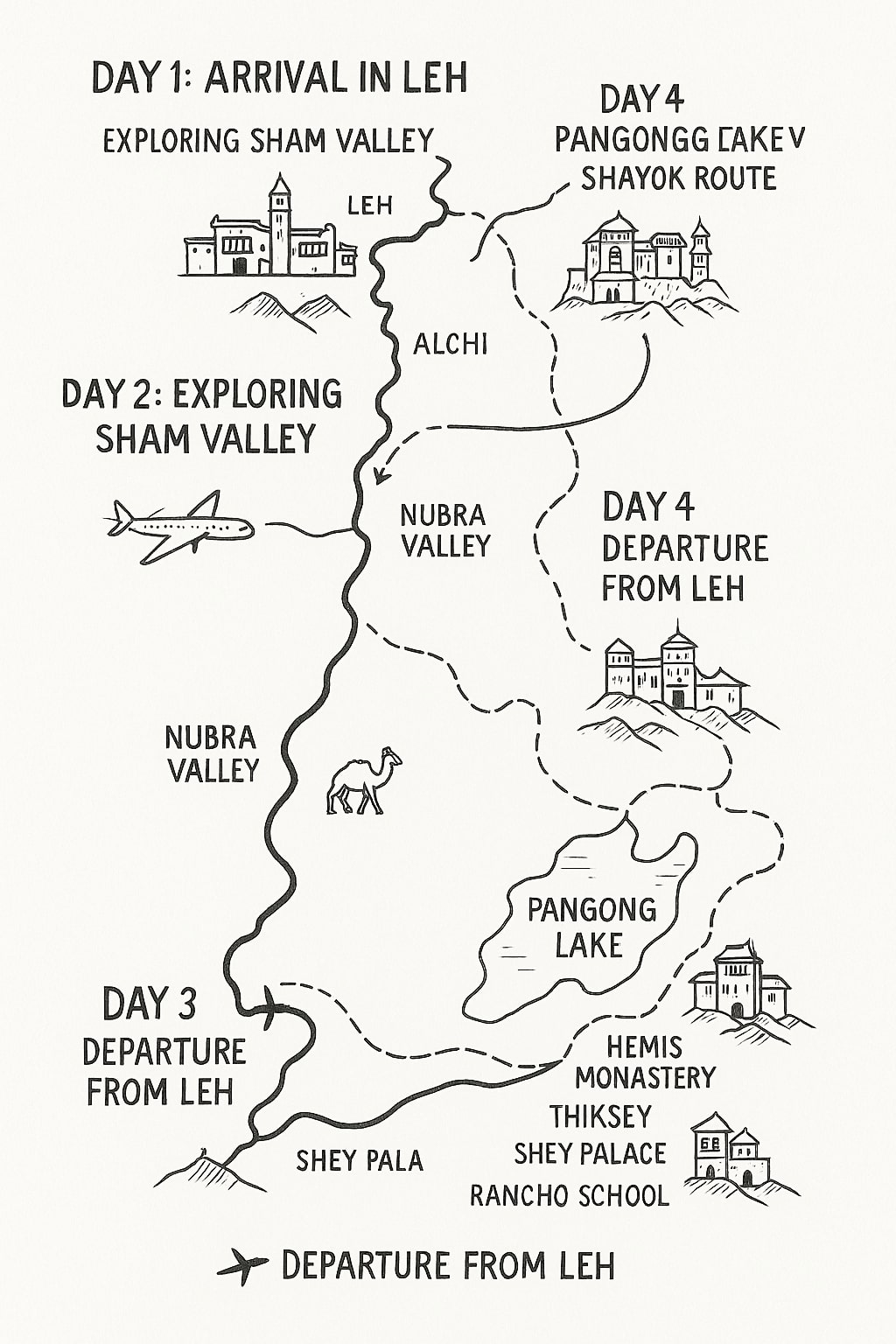
Apr – Sept
710 – 750km
5 Nights – 6 Days
Your journey begins with an arrival in Leh, where you’ll immediately focus on acclimatizing to the high altitude, followed by a gentle introduction to local culture through Leh Market. The exploration deepens on Day 2 with a journey through Sham Valley, visiting ancient spiritual sites like Lamayuru Monastery and Alchi Monastery, capped by the serene night views from Shanti Stupa. Day 3 brings adventure as you traverse the mighty Khardung La pass into Nubra Valley’s desert landscapes, where you’ll experience camel rides among sand dunes and visit the commanding Diskit Monastery with its towering Maitreya Buddha.
The itinerary then shifts to one of Ladakh’s most iconic destinations on Day 4 – a scenic drive along the Shayok River leads you to the ethereal, color-shifting waters of Pangong Lake, where you’ll spend the night immersed in its tranquil beauty. Waking to a Pangong sunrise, Day 5 takes you back toward Leh via Chang La Pass, punctuated by cultural discoveries at Hemis Monastery (Ladakh’s largest), the Potala-like Thiksey Monastery, historic Shey Palace, and the playful Rancho’s School. Your memorable journey concludes on Day 6 with a departure from Leh, carrying the essence of Ladakh’s stark landscapes and profound spirituality with you. This well-paced route balances high-altitude thrills, cultural immersion, and natural wonders.
Day 1: Arrival in Leh
Day 2: Exploring Sham Valley
Day 3: Leh to Nubra Valley (via Khardung La)
• Journey through Khardung La Pass (5,359m), one of the world’s highest motorable passes.
• Reach Nubra Valley, a cold desert with dramatic landscapes.
• Enjoy a camel ride in Hunder, experiencing the unique double-humped Bactrian camels.
• Visit Diskit Monastery, home to the grand Maitreya Buddha statue.
• Explore the mesmerizing sand dunes of Nubra Valley.Day 3: Leh to Nubra Valley (via Khardung La)
Day 4: Nubra to Pangong Lake via Shayok Route
Day 5: Pangong to Leh (via Hemis, Thiksey, and Shey)
Day 6: Departure from Leh
• Transfer to the airport for departure, carrying memories of Ladakh’s mesmerizing landscapes and cultural richness.
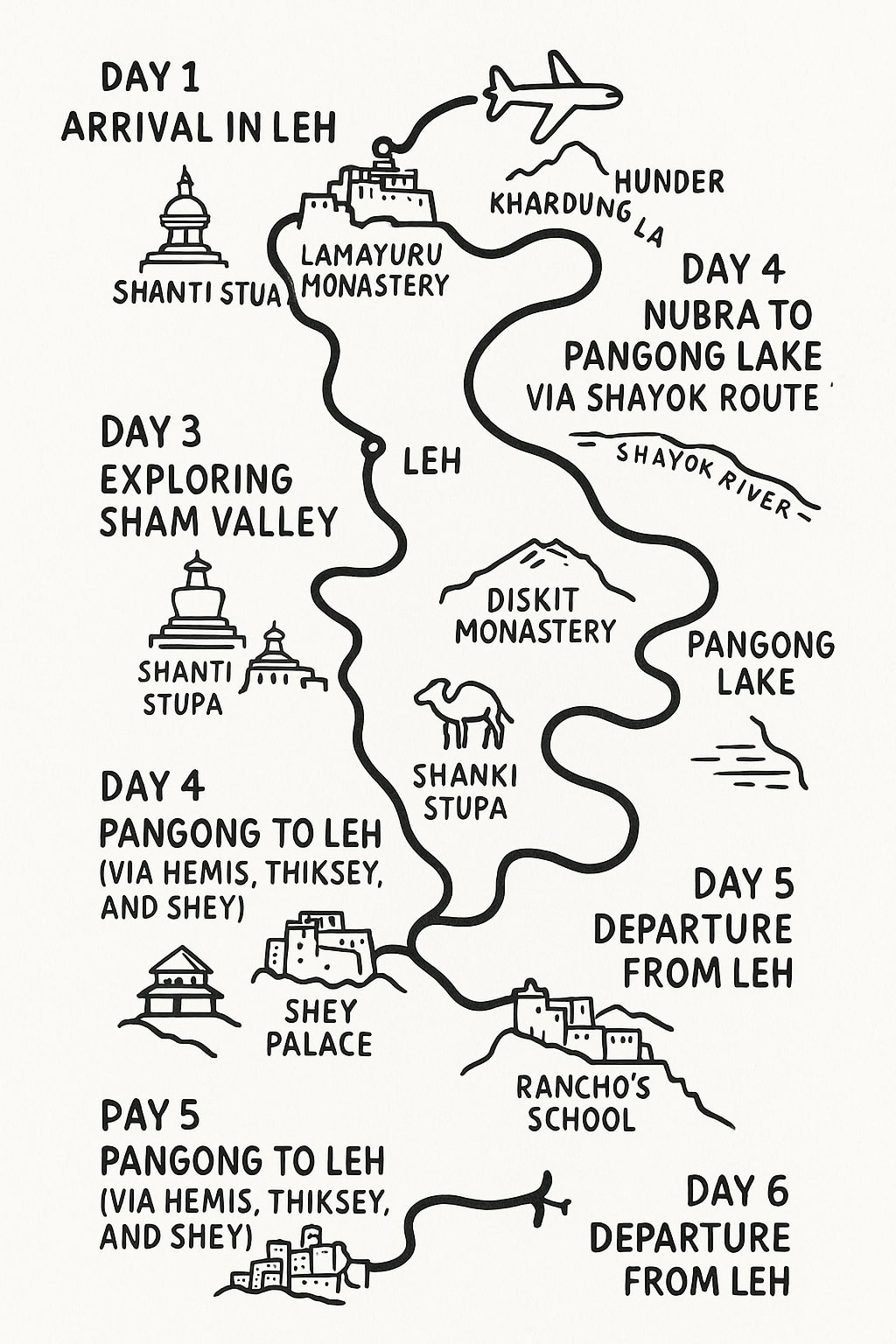
Apr – Sept
800 – 850km
6 Nights – 7Days
Your adventure begins in Leh (3,500m), where you’ll acclimatize to the high altitude and explore the vibrant local market. On Day 2, you venture into Sham Valley, visiting the ancient Lamayuru Monastery—perched amidst surreal moon-like landscapes—before returning to Leh. Day 3 takes you over the mighty Khardung La pass (5,359m) into Nubra Valley’s cold desert, where you’ll ride double-humped camels on Hunder’s dunes and witness the towering Maitreya Buddha at Diskit Monastery.
Day 4 unveils the remote village of Turtuk near the Indo-Pak border, offering a glimpse into Balti culture amid apricot orchards and rugged mountains. The journey continues on Day 5 along the Shayok River to the ethereal Pangong Lake (4,350m), where you’ll spend an evening captivated by its shifting blue hues. At sunrise on Day 6, you’ll bid farewell to Pangong and cross Chang La pass en route to Leh, stopping at Hemis (Ladakh’s largest monastery), the Potala-inspired Thiksey, historic Shey Palace, and Rancho’s School. Your expedition concludes on Day 7 with a transfer to Leh Airport, carrying memories of Himalayan grandeur and cultural wonders.
Day 1: Arrival in Leh
Day 2: Exploring Sham Valley
• Visit Sham Valley, known for its scenic landscapes and cultural sites.
• Explore Lamayuru Monastery, one of the oldest and most picturesque monasteries in Ladakh, surrounded by unique moon-like terrain.
• Return to Leh in the evening and relax.
Day 3: Leh to Nubra Valley (via Khardung La)
Day 4: Excursion to Turtuk – Back to Nubra
Day 5: Nubra to Pangong Lake via Shayok Route
Day 6: Pangong to Leh via Chang La Pass
Day 7: Departure from Leh
• Transfer to the airport for departure, carrying memories of Ladakh’s mesmerizing landscapes and cultural richness.
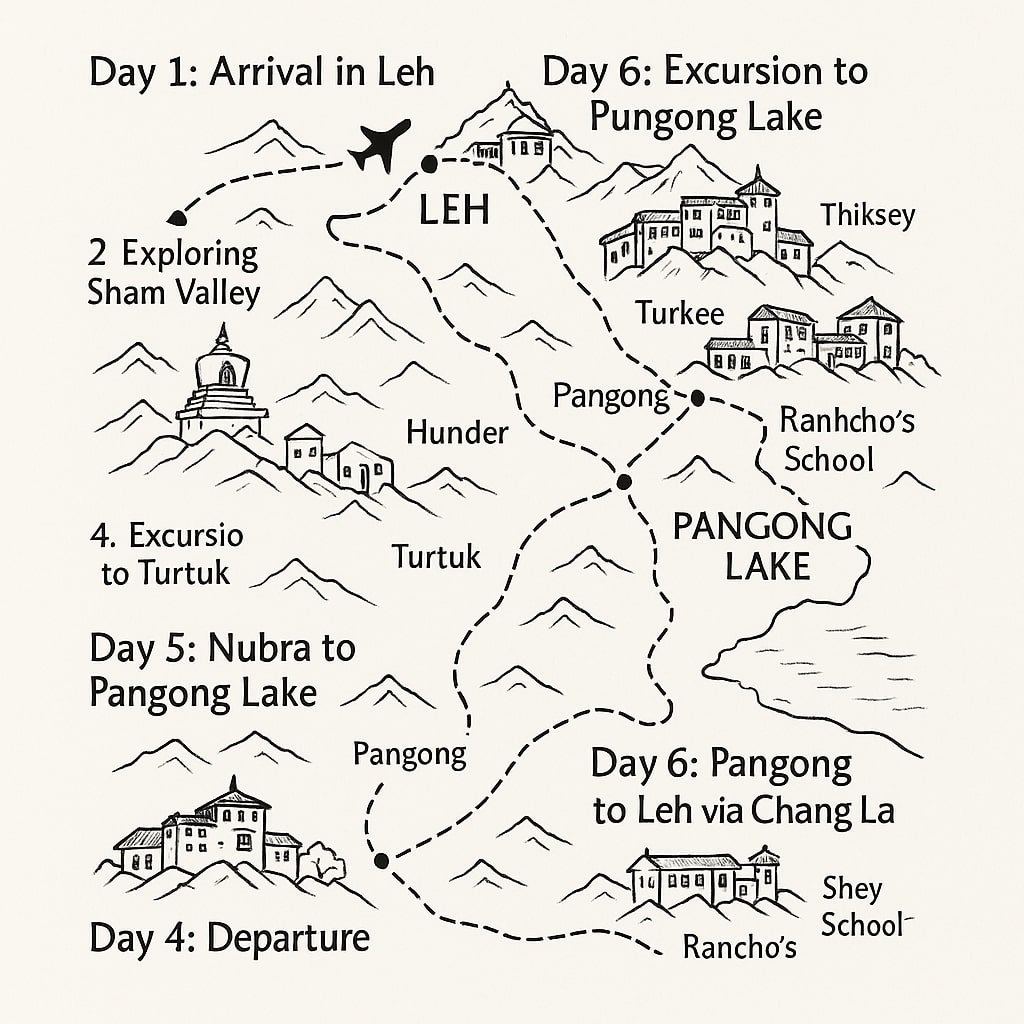
Apr – Sept
880 – 920km
7 Nights – 8 Days
Your journey begins with an arrival in Leh, landing amidst stunning Himalayan vistas before transferring to your hotel. The first day is dedicated to gentle acclimatization, allowing you to soak in the atmosphere, perhaps explore locally, and witness a serene Ladakhi sunset.
Day two takes you along the Leh-Srinagar Highway to explore Sham Valley. You’ll visit significant sites including the Hall of Fame Museum honouring the Indian Army, the revered Gurudwara Patthar Sahib, the intriguing Magnetic Hill, the dramatic Indus-Zanskar river confluence, and the ancient Spituk Monastery, returning to Leh by evening.
The adventure heightens on day three with an early drive across the formidable Khardung La pass, one of the world’s highest motorable roads, descending into the unique Nubra Valley. Here, you’ll encounter unexpected white sand dunes and have the option for a distinctive Bactrian camel safari before staying overnight in the valley.
Day four delves deeper into cultural discovery with a trip to the remote village of Turtuk, opened to tourists relatively recently. You’ll experience Balti traditions, explore ancient landmarks, and witness life near the Line of Control, reflecting on the day’s experiences back in Nubra Valley.
Day five starts with a visit to the commanding Deskit Monastery offering panoramic views. The journey then continues through rugged terrain along the Shayok route to reach the iconic, high-altitude Pangong Lake, spending the evening immersed in its breathtaking and tranquil beauty on the Indo-China border.
Leaving Pangong Lake on day six, you traverse the high Chang-la Pass back towards Leh. The return route includes enriching stops at the impressive Thiksey Monastery, the famous Rancho School, and the historic Shey Palace, arriving back in Leh by evening.
Day seven focuses on Leh itself, exploring the city’s key attractions: the peaceful Shanti Stupa with sweeping views, the historic Leh Palace, and the vibrant Leh Market for local crafts and cuisine, culminating in a final evening of relaxation and reflection.
Your memorable journey concludes on day eight with a transfer to Leh Airport, carrying with you the profound landscapes and rich cultural tapestry of Ladakh.
Day 1: Arrival in Leh
Day 2: Exploring Sham Valley
Day 3: Leh to Nubra Valley (via Khardung La)
• • Overnight in Nubra.
Day 4: Turtuk Village Discovery
• • Evening reflection in Nubra Valley.
Day 5: Deskit Monastery – Pangong Lake
Day 6: Return to Leh via Chang-la Pass
Day 7: Leh City Tour
Day 8: Departure
• Transfer to Leh Airport with memories of Ladakh’s landscapes and culture.
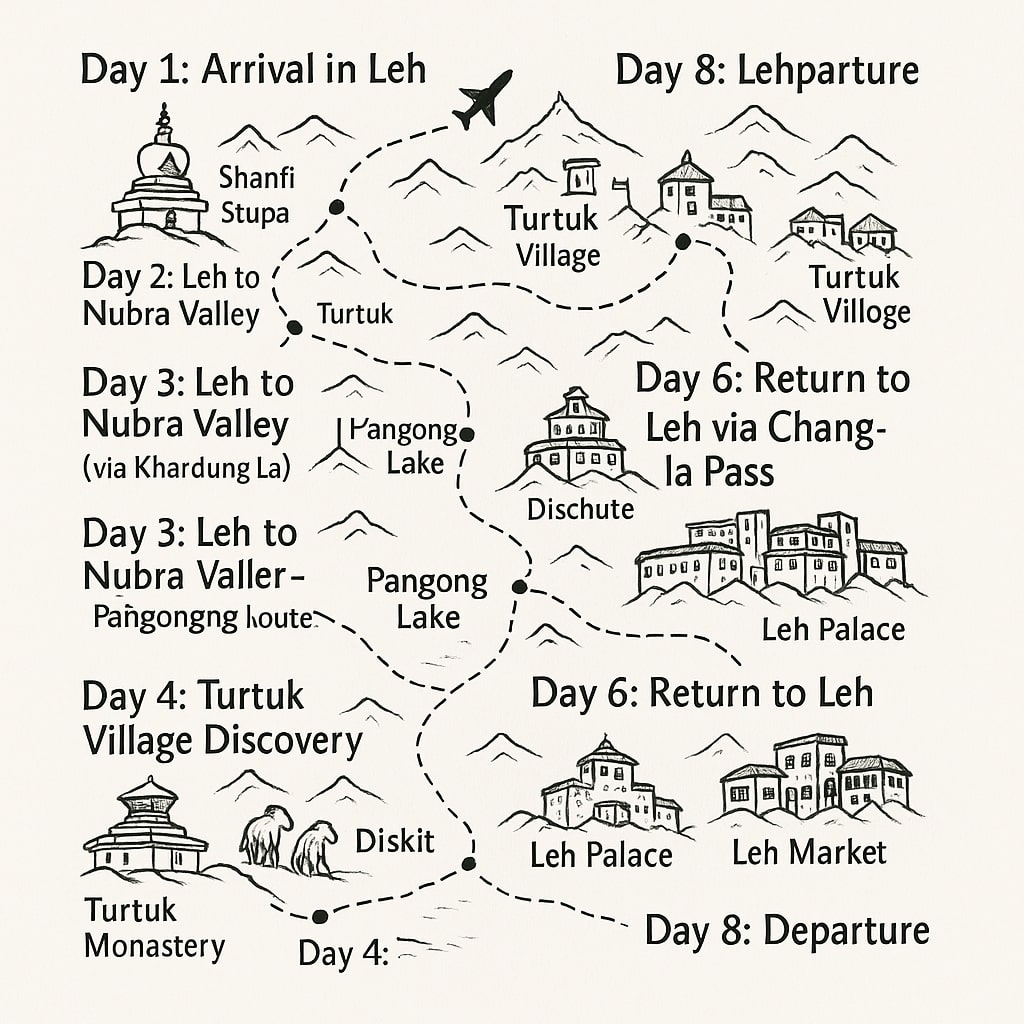
Apr – Sept
1200 – 1300km
14 Nights – 15 Days
Your journey begins in Leh (11,500 ft), where cautious acclimatization sets the rhythm—rest, hydration, and gentle market strolls amid Himalayan air. Day 2 unveils Leh’s soul: peace at Shanti Stupa, royal echoes in Leh Palace, and valor honored at the Hall of Fame Museum, capped by momos under starlit skies.
On Day 3, conquer Khardung La (17,982 ft), the planet’s highest motorable pass, descending into Nubra Valley. Here, double-humped Bactrian camels tread surreal dunes beneath Diskit Monastery’s watchful Maitreya Buddha. Day 4 pushes north to Turtuk—India’s last frontier—where Balti hospitality, apricot orchards, and a Brokpa king’s palace reveal a world untethered from time. Day 5 deepens the connection: meditate at Samstanling Monastery, hike to the hidden mirror of Yarab Tso Lake, and unwind by the Shyok River’s turquoise flow.
The quest for blue intensifies on Day 6. Traverse the rugged Shyok Valley to Pangong Lake (14,270 ft), its Tibetan hues shifting from cobalt to sapphire as the sun sets. After a night in oxygen-aided camps, Day 7 ventures higher: cross Tsaga La (15,200 ft), pay homage at Rezang La War Memorial, and reach Hanle—home to the Indian Astronomical Observatory and a 17th-century monastery whispering Kagyu prayers. Day 8 crowns the ascent: Umling La (19,024 ft), the world’s rooftop, demands permits and oxygen cylinders but rewards with thin-air triumph. As night falls, galaxies blaze overhead in Hanle’s Dark Sky Reserve.
Day 9 trades stars for serenity at Tso Moriri (14,800 ft), an alpine jewel where kiangs gallop and migratory birds skim waters guarded by Changthang’s peaks. The return to Leh on Day 10 weaves through Taglang La (17,582 ft), with valleys painting farewell vistas. Days 11–12 pivot to history: Kargil’s gravity-defying Magnetic Hill and Zanskar-Indus confluence precede the Kargil War Memorial at Dras—India’s frozen battleground—where Tiger Hill’s silence speaks volumes.
Your finale (Days 13–15) winds through Nimmu Valley’s river symphonies, embraces last-minute pashmina treasures in Leh, and departs with Ladakh’s essence: wind-carved cliffs, monastery chants, and skies that touch the soul.
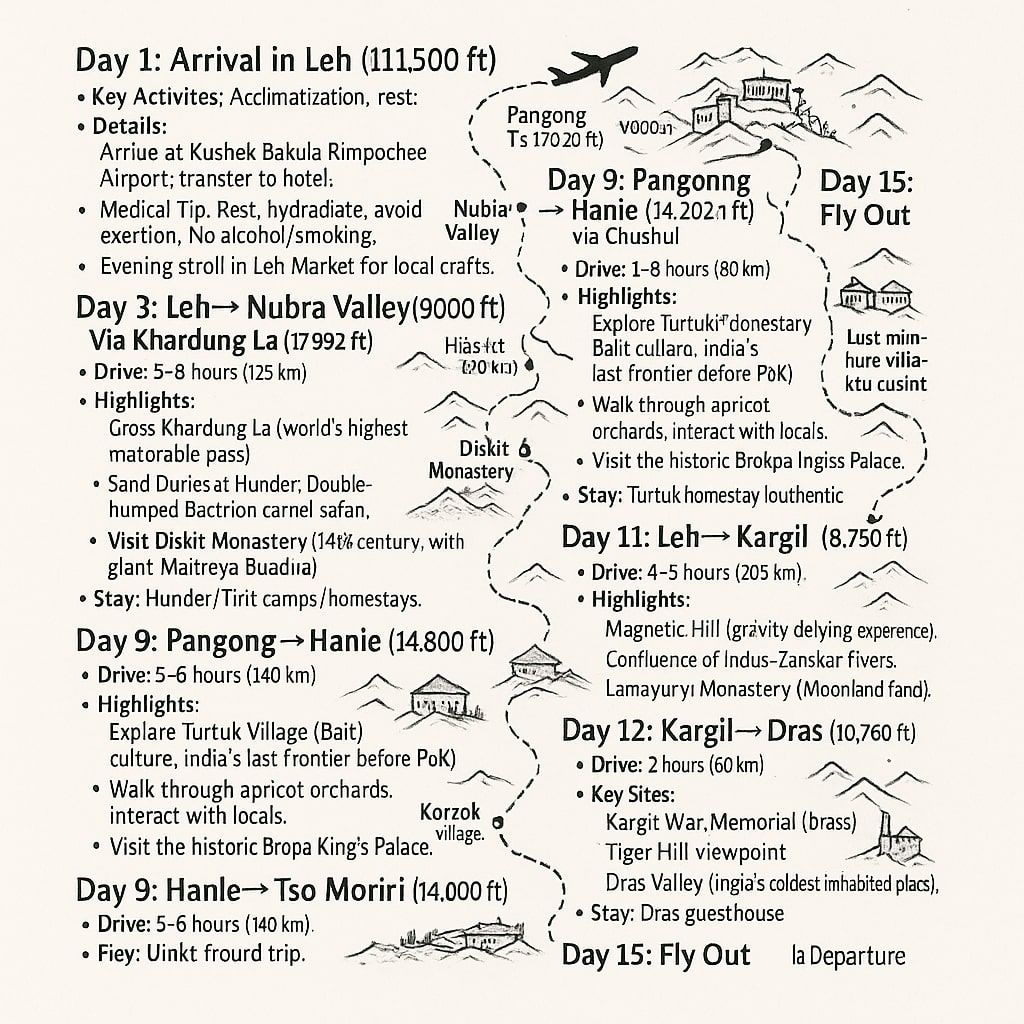
Apr – Sept
320 – 350km
4 Nights – 5 Days
Your Kashmir adventure begins in Srinagar, where Day 1 unfolds amid Mughal grandeur—stroll through terraced gardens at Chashme Shahi, wander the mystical corridors of Pari Mahal, and lose yourself in the perfumed elegance of Shalimar and Nishat Bagh. As dusk paints Dal Lake gold, settle into your hotel or a charming houseboat.
On Day 2, ascend to Gulmarg, the “Meadow of Flowers.” Glide over pine forests on a gondola ride, trot through alpine meadows on a pony, and let laughter echo in Strawberry Valley or the Children’s Park. Return to Srinagar as the Pir Panjal range blushes at sunset.
Day 3 sweeps you into Pahalgam, the Valley of Shepherds. Feel Bollywood magic in Betaab Valley’s emerald expanses, breathe crisp mountain air in Aru Valley, and seek blessings at the ancient Mamal Temple before resting amidst Himalayan whispers.
Day 4 returns you to Srinagar’s pulse: climb to Shankaracharya Temple for panoramic lake views, haggle for saffron and crafts at Lal Chowk, then surrender to the gentle rock of a houseboat on Dal Lake—your floating sanctuary under starry skies.
Your journey closes on Day 5 with a serene shikara glide past lotus blooms before departing with memories of gardens, gondolas, and Kashmir’s timeless grace.
Day 1: Arrival in Srinagar – Mughal Gardens
Day 2: Srinagar – Gulmarg (Meadow of Flowers)
Day 4: Srinagar City Tour & Houseboat Stay
Day 5: Departure from Srinagar
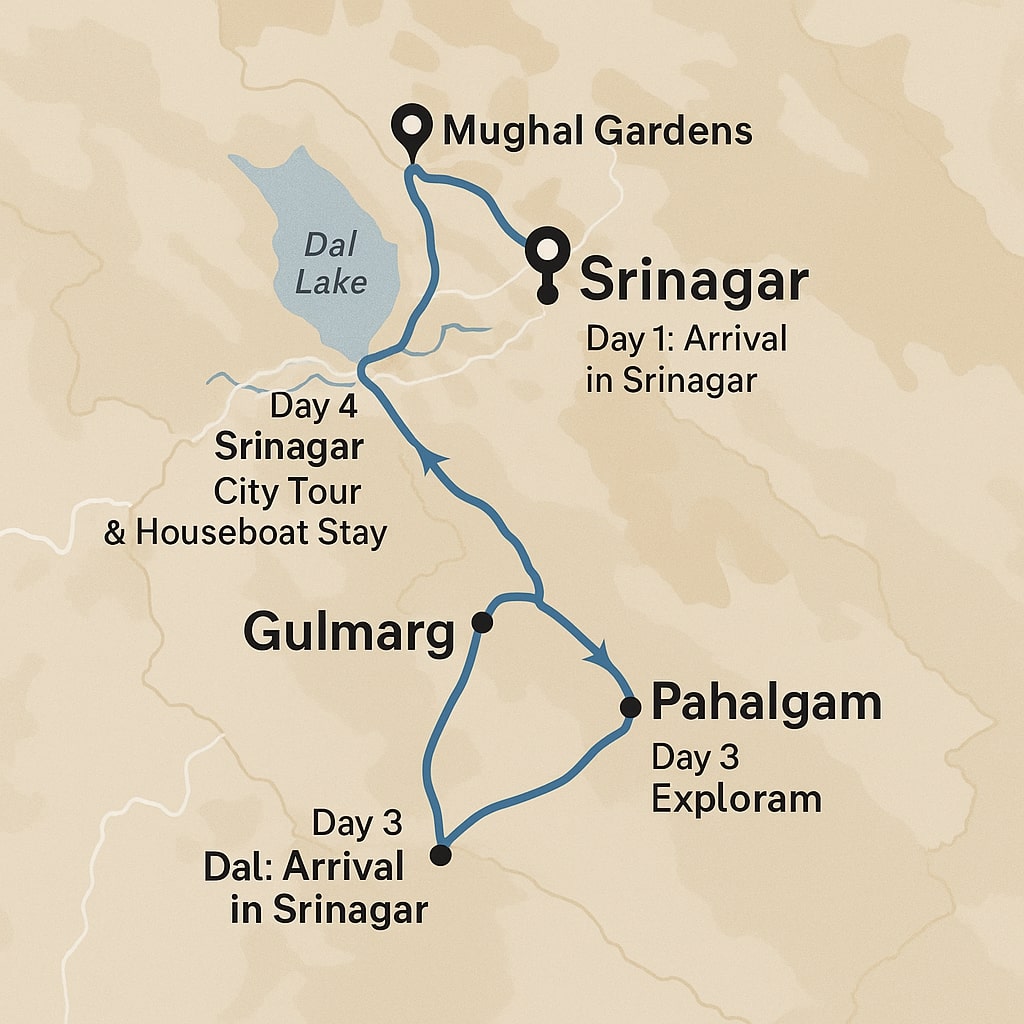
The Himalayan Earth Views, Leh Stumpa, Upper Tukcha Rd, Leh, Ladakh 194101
+91 84939 26570, +91 99069 90304
bookings@thehimalayanearthviews.com
